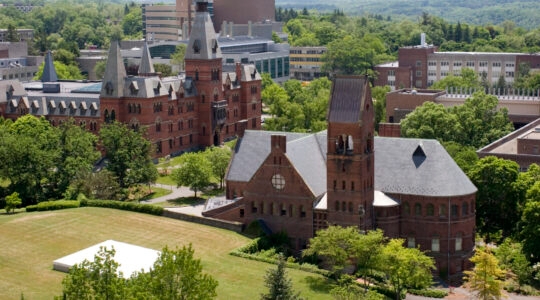(JTA) — The shooting on Saturday that left one woman dead and three injured happened in a synagogue focused on welcoming and outreach.
The shooter, who has been apprehended by police, entered the synagogue, Chabad of Poway, at approximately 11:30 a.m. and began shooting. He is 19 years old and appeared to have had anti-Semitic intent. The shooting took place on the last day of Passover, and six months to the day after the synagogue shooting in Pittsburgh that left 11 dead.
Chabad of Poway is a branch of the Chabad-Lubavitch movement, a Hasidic group with emissaries across the globe who are focused on reaching out to unaffiliated Jews. While its rabbis are haredi Orthodox, its congregants are often secular or nonobservant Jews seeking to learn more about Judaism and its rituals.
Here’s what you need to know about the movement at the center of Saturday’s tragedy near San Diego.
Chabad focuses on encouraging Jews to connect to their tradition.
Chabad was founded in the 18th century in Lubavitch, a small town in Russia. It is a Hasidic movement, which means that its followers have traditionally focused on Jewish spirituality and mysticism. Chabad is a Hebrew acronym that stands for “intelligence, understanding and knowledge.”
Its grand rabbi and his followers moved from Europe to the United States following the outbreak of World War II and the Holocaust. Since then, it has been based in the Brooklyn neighborhood of Crown Heights.
The movement was transformed in 1951 when its most recent grand rabbi, Menachem Mendel Schneerson, took the helm. Following the Holocaust, he expanded a program that sent rabbis as emissaries to Jewish communities in cities around the world. The rabbis’ goal is to teach Jews about Jewish history, philosophy and practice, and to engage them in Jewish life.
Schneerson died in 1994, but the emissary program has only grown. There are now nearly 5,000 emissary families (generally a rabbi, his wife and children) in 100 countries, as well as all 50 states and 500 college campuses.
The rabbis are Orthodox, but the followers often are not.
Chabad rabbis fit the profile of haredi Jews: They wear black hats, long beards and dark suits, and stringently follow Orthodox Jewish law. But the emissaries’ target audience is usually not other Orthodox Jews.
Many Chabad centers, including the synagogue in Poway, explicitly aim to reach Jews with little background in Judaism. Their modus operandi is to teach and model Orthodox Judaism in a nonjudgmental and welcoming way through Friday night dinners, classes and activities for families. Chabad of Poway’s website calls the synagogue a “popular center for Jews of all backgrounds who want to learn more about their Jewish roots,” and advertises “the Chabad-Lubavitch approach of joy, scholarship and unconditional acceptance and love for every Jew.”
Chabad is also the movement behind the young men and boys who will set up shop on street corners in New York City and elsewhere, asking people if they are Jewish and offering men the opportunity to put on tefillin, or phylacteries.
There are also Chabads in places with few Jews, like in Kinshasa, Congo. The Chabad house in Mumbai, India, was targeted in a 2008 terror attack that killed the emissary couple there.
Some Chabad followers believe Schneerson, the late grand rabbi, is the Messiah.
Schneerson, who led Chabad for more than 40 years before his death in 1994, was a charismatic and influential leader who transformed the movement. His legacy has remained so powerful within Chabad that the movement has not named a new grand rabbi since his passing. Some Chabad Hasidim believe he is the Messiah and will return to the world.
The belief spawned a “messianist” faction within the movement. But many emissaries do not believe in Schneerson as Messiah and do not teach that belief at their Chabad centers.
Chabad rabbis have become connected to powerful officials globally, including Vladimir Putin and Jared Kushner and Ivanka Trump.
Chabad operates as a loose network, and emissaries for the most part tend to work independently — responsible for their own programming, fundraising and priorities. But some Chabad rabbis have become connected to powerful people.
Berel Lazar, for instance, one of two chief rabbis of Russia, is an ally of Russian President Vladimir Putin. Chabad ran a clandestine network of emissaries in the Soviet Union and has grown in Russia since the USSR’s collapse three decades ago.
And in Washington, D.C., Jared Kushner and Ivanka Trump attend a Chabad synagogue. Kushner, President Donald Trump’s son-in-law and senior adviser, has been involved with Chabad since he was a student at Harvard University.
Relations between Chabad and other Jewish religious denominations are sometimes strained over turf and philosophical issues, but the other movements have also looked to Chabad as an example in outreach programming, and using the internet and social media to engage unaffiliated Jews.
JTA has documented Jewish history in real-time for over a century. Keep our journalism strong by joining us in supporting independent, award-winning reporting.






